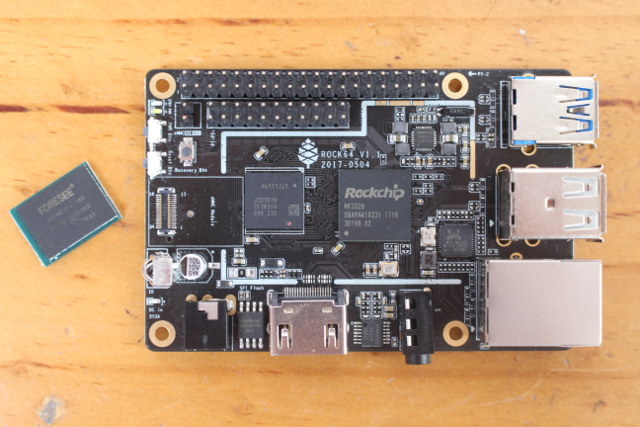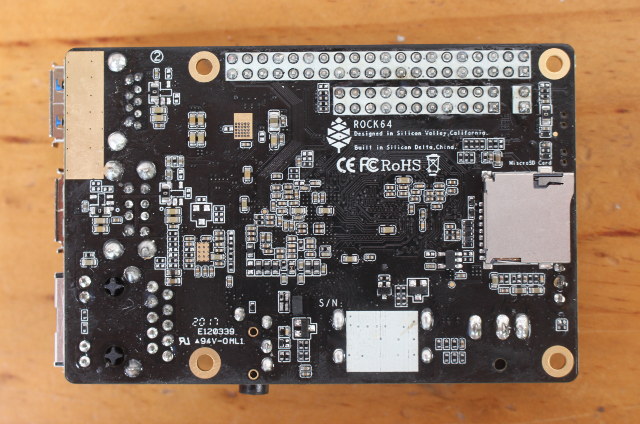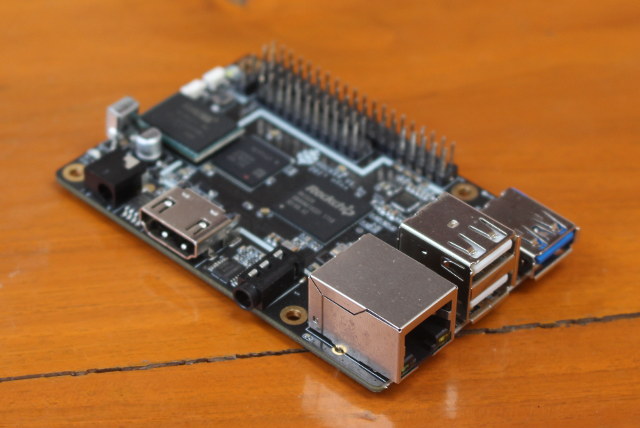Rockchip RK3328 Android TV boxes such as A5X Plus or A95X R2 have been on the market for a couple of months, but since the processor is rather inexpensive, yet supports 4K UHD video output, Gigabit Ethernet and USB 3.0 interfaces, Pine64 has decided to create a new development board called ROCK64 with a form factor similar to Raspberry Pi 3 board.

ROCK64 board specifications:
- SoC – Rockchip RK3328 quad core Cortex A53 processor with ARM Mali-450MP2 GPU
- System Memory – 1, 2, or 4 GB LPDDR3 @ 1866 MHz
- Storage – eMMC flash module socket + micro SD card slot + 128 Mbit SPI flash
- Video & Audio Output – HDMI 2.0a up to 4K @ 60 Hz with HDR10 and HLG support, 3.5mm AV port (composite video + stereo audio)
- Video Codec – 4K VP9, H.265 and H.264, 1080p VC-1, MPEG-1/2/4, VP6/8
- Connectivity – Gigabit Ethernet
- USB – 2x USB 2.0 ports, 1x USB 3.0 port
- Expansion Headers
- 40-pin Pi-2 Bus with GPIOs, 2x I2C, Analog inputs, UART, SPI, and power signals (5V, 3.3V, and GND)
- 22-pin Pi-P5+ Bus with GPIOs, I2S, S/PDIF, Ethernet, and power signals (5V, 3.3V, and GND)
- Misc – IR receiver; power, recovery & reset buttons; eMMC jumper
- Power Supply – 5V/3A via 3.5mm/1.35mm power barrel
- Dimensions – 85 x 56 mm

The board will support various operating system including Android 7.1, Debian, Yocto Linux, and more. Some of the source code and software development tools are already available in github.
The board will be launched on the first of July, but price has not been announced yet due to the recent DRAM price hike. For reference, RK3328 TV boxes with 1GB RAM now sell for around $35 and the ones with 2GB RAM for around $45. Those prices include shipping and all accessories, and considering Pine64’s usually aggressive pricing, ROCK64 board may be sold for around $25 (1GB RAM), $35 (2GB RAM) and $45 to 50 (4GB RAM) excluding shipping. You’ll find a few more details, including PDF schematics and pinout diagrams, in the product page.

Update: I’ve just received my board, and updated the pictures above. I also came with a FORESEE eMMC module (see first picture), and a 5V/3A power supply.

Jean-Luc started CNX Software in 2010 as a part-time endeavor, before quitting his job as a software engineering manager, and starting to write daily news, and reviews full time later in 2011.
Support CNX Software! Donate via cryptocurrencies, become a Patron on Patreon, or purchase goods on Amazon or Aliexpress




